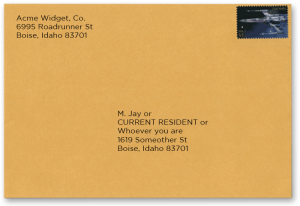
For all the talk about how creepy and stalker-like marketing personalization has become, the simple fact is that it has been around long enough to establish itself as an expected component in modern marketing communications. Even in an age where social media and government spying has made audiences wary of how their personal data is used by companies and marketers alike, lack of personalization is often viewed as a “snub” and can make a company feel “out of touch.”
Don't believe me? When's the last time you've opened a letter addressed to “Current Resident?”
Personalization Works
To help plead the case of the effectiveness of personalization, I brought some friends — Namely InfoTrends & The Direct Mail Association among others, and a cave man, because it's so easy… well you get the idea:
- A 2007 InfoTrends/CAP Ventures personalization study found that personalized direct mail has 3X the response rate of non-personalized direct mail.
- According to the Direct Mail Association, close to 33% of consumers go online in response to direct mail. This response rate is increased by 20-30% when a personalized URL addresses (e.g. YourName.OurCampaign.com) and personalized landing pages are used.
- A survey conducted by Prospectiv revealed that 80% of consumers stated that personalized coupons tailored to their interest would increase the likelihood of coupon use.
- 42% of consumers read direct mail that addresses their unique needs. (Customer Focus®: Direct Mail Study 2007)
- Cap Ventures also found that repeat orders were increased by 48% when personalization was used.
We can go on and on, but I think you get the general idea: Personalization Good!
It's All in the List
This is where personalization can fall flat very quickly, and it's what I mean by “It's Not Who You Know, But What You Know About Who.” It's great that you have the CEO of GM Motors on your mailing list, but if you only know her as “M. T. Barra” and have no other personal information about her, nor any knowledge of her specific needs or purchasing habits, you won't get very far. Imagine her delight when she receives your direct mail piece with the tagline:
“Hi M.! Are you ready to throw away that gas-guzzling automobile and start riding a brand new Schwinn?”
Bottom line: personalization is only as good as the information that created it, so if your list is full of incomplete or incorrect information, it will definitely be worth your time to clean it up. Here's a few tips to get you started:
- Segregate your list by data quality (good & bad)
- Segregate your “good” list by industry & interests
- Compare your “bad” list with your CRM, sales notes or any other sources of customer data you may have to see if you can salvage some of the data
- Keep the remaining “bad” data quarantined until it can be converted to usable data.
What If I Don't Have a List?
Not every company has a large database of existing customers, and even the ones who do might be interested in finding some new customers. Luckily, there are several sources for obtaining a fresh list of potential prospects. Purchased lists can be targeted to demographics such as age groups, zip codes, ethnicity, interests, education, income and purchasing habits.
Some food for thought: Purchasing lists for direct mail is the sales equivalent of a cold call, as you have no prior business relationship with them, and you can rest assured that this will affect your overall response rate. Regardless, highly targeted, highly personalized direct mail campaigns aimed at groups with proven interest in your products and services can be a highly effective way to gain new prospects and increase sales.
Note that the same can NOT be said for purchased email lists. Use your Inbound marketing strategies, direct mail campaigns, web forms, social media, phone & in-person communications to organically build your email marketing lists, and NEVER use spammy tactics liked purchased email lists for marketing your brand or services. This will inevitably cause more harm than good.


